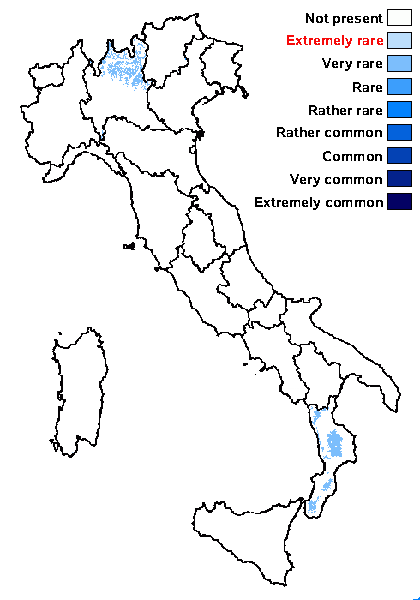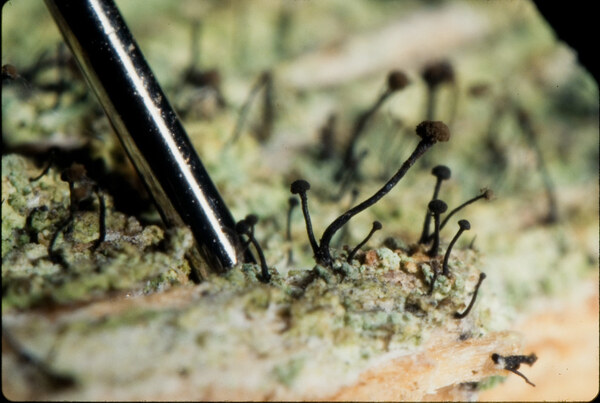Chaenothecopsis epithallina Tibell
Symb. Bot. Upsal., 21, 2: 116, 1975.
Synonyms:
Distribution: N - Lomb (CLU 2040). S - Cal (Puntillo 1994, 1996, Puntillo & Puntillo 2009, Brackel & Puntillo 2016, Brackel 2016).
Description: Thallus not evident, not lichenized. Apothecia long-stalked, 0.6-1 mm high, pin-like, developing on the thalli of Chaenotheca trichialis. Stalk 0.05-0.07 mm thick, black, epruinose, 0.08-0.1 mm thick, consisting of an outer, 6-9 µm thick layer of strongly sclerotized, dark brown hyphae, and an inner part of iregularly interwoven, colourless and swollen hyphae. Capitulum lenticular 0.3-0.4 mm across, the outer part faintly bluish white-pruinose; mazaedium not present. Exciple dark brown, 20-50 µm thick (thickest at the base), 3-layered, the innermost and median layer of periclinally arranged hyphae, the outer layer of more or less isodiametrical cells with sclerotized walls. Epithecium brown, poorly evident; hypothecium aeruginose green, 60-80 µm high. Asci 8-spored, cylindrical, with a thickened apex penetrated by a narrow canal, formed singly, persisting until the spores are mature. Ascospores 1-septate, brown, ellipsoid, 6-8 x 2-2.5 µm, with a smooth wall, the septum clearly pigmented, at least as dark as the wall. Photobiont absent. Spot tests: all parts of ascocarps K-, C-, KC-, P-, N-. Chemistry: without lichen substances.Note: parasitic or parasymbiontic in the thalli of Chaenotheca trichialis, mainly on old conifers, much more rarely on lignum and deciduous trees, mostly in upland areas; probably occurring in the Alps, but very much overlooked. The record from Sicily by Grillo (1996), not validated by Puntillo & Puntillo (2009) is not accepted here.
Growth form: Lichenicolous fungus
Substrata: bark
Reproductive strategy: mainly sexual
In underhangs rarely wetted by rain
paras Chaenotheca trichialis
Commonnes-rarity: (info)
Alpine belt: absent
Subalpine belt: very rare
Oromediterranean belt: absent
Montane belt: very rare
Submediterranean belt: absent
Padanian area: absent
Humid submediterranean belt: absent
Humid mediterranean belt: absent
Dry mediterranean belt: absent

Predictive model
Herbarium samples
Growth form: Lichenicolous fungus
Substrata: bark
Reproductive strategy: mainly sexual
In underhangs rarely wetted by rain
paras Chaenotheca trichialis
Commonnes-rarity: (info)
Alpine belt: absent
Subalpine belt: very rare
Oromediterranean belt: absent
Montane belt: very rare
Submediterranean belt: absent
Padanian area: absent
Humid submediterranean belt: absent
Humid mediterranean belt: absent
Dry mediterranean belt: absent

Predictive model
| Herbarium samples |
 INDEX FUNGORUM
INDEX FUNGORUM
 GBIF
GBIF


